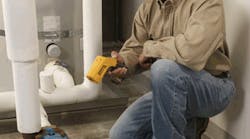When applied to blowers and pumps, variable-frequency drives (VFDs) offer energy savings. In mechanical applications, they allow fine adjustments that wouldn't be possible by other methods. Despite their popularity in multiple applications, they are not simple plug-in-and-forget devices. Because VFDs are full of electronics, they're susceptible to all sorts of problems — from incoming power disturbances to environmental hazards to wrong operation, not to mention one or two unexpected issues that may arise. The motors they drive present their own set of challenges.
I work with motors (from 300 hp down to 1/16 hp) and variable-speed drives on a daily basis. During my 24 years of practical experience, I've learned a great deal about troubleshooting different situations. Here's a list of practical tips to keep your motors up and running as well as common errors to avoid.
Start with baseline readings
Don't just take a motor out of the box, throw it in place, and hope for the best. Before putting a motor into full operation, take insulation resistance readings from phase-to-phase and phase-to-ground. Measure the insulation resistance of the windings using an insulation multimeter to determine what a good reading is. In addition, measure the starting and running amperage, the running voltage, and the leg-to-leg balance.
Measure the temperature at first startup (unloaded, loaded) and after a period of use. A motor may run hot because it's been used hard, is in a high-temperature area, or has a problem. Without knowing its normal temperature, it's difficult to tell which is the case. It's nice to know whether motors are running hot or not. A lot of times, you won't see any problems until the heat really builds up. For example, the inside temperature near the glass tempering ovens in my plant in the summertime is normally about 130°F.
You should also measure temperature using an infrared thermometer or a thermocouple connected to an insulation multimeter. It's good to compare results between the various methods.
Make other measurements periodically
Depending on your preventive maintenance (PM) schedule and the cost of unscheduled downtime, take additional amperage, resistance, and insulation resistance readings. Compare these readings to previous readings. If the measurements deviate by more than 5% to 10%, start looking for bad electrical connections or loose/ill-fitting mechanical connections. Has the load increased, the frequency of use changed, or have ambient temperatures increased/decreased?
Find out if the motor matches the application and was specified for the system, or if upgrades are needed.
Check the protection
Look at the protection systems, the overload contactors, and fusing. Is the overload set for full load amperes, or is it set too high or low? Is the fusing correct for the application? Overload contactors are designed to take care of overloads, while fuses and circuit breakers are intended for short circuit protection. Are they sized according to the load? Do the fuses blow without tripping the overload? Are the fuses rated properly?
If the fuses blow repeatedly, there's a temptation to replace them with higher-rated fuses. But if some time later the overload decides to short across itself and doesn't trip any more, suddenly those fuses that are too high will make the motor cook. That means a lot of back-checking, pulling out the manuals (if they're available), or looking at the nameplate data.
Don't change parts instead of troubleshooting
Some technicians will change out parts until the trouble goes away. This is an expensive way to troubleshoot, because most motors and drives start at $500 and up. It's not unusual to find that the same motor/drive that had failed may start working in another application.
This makes the job of finding the original problem harder, because the failure was only temporary. Was it the loading, application, or a combination of things that led up to the failure?
Cabling can be an issue, too
Check the line at the motor, not just at the panel on the wall, which may be 100 ft away. Power lines in hostile (e.g., high-temperature) areas, even when protected by conduit, may fail. Checking the voltage at the panel and not at the motor may result in replacing a perfectly good motor when the problem is in the wiring.
Look at the drive's setup and parameters. Check the acceleration and deceleration times. Are you running at line frequency (higher or lower)?
Make sure it's the right motor
Sometimes, motors are put into applications for which they are not designed. Inverter-rated motors make a big difference in the longevity of the system. Running a standard-duty motor at 50 Hz, for example, often leads to overheating. Similarly, running it at 90 Hz or 120 Hz may work for a while, but the motor can't accept that as a steady diet.
The duty cycle of the motors will help determine where and what application they are suited. A motor designed to run 8 hr a day, five days a week, will fail prematurely if it has to run 24/7.
Nameplate data is an important troubleshooting tool. It will tell the motor's service factor, the duty cycle, and more. It will also provide useful information about the protection circuits and fusing.
Continue on Page 2
Check for power problems
Many drive failures come from power spikes, phase loss, or undervoltages. After a power issue, it's important to measure the power to see if the problem has been corrected or is still happening. If you don't check the power after an outage, the drives will pay the price. When the power comes back after an outage, the machine operators may just automatically restart and try to run again. Suddenly, you start popping drives and burning up motors because of single-phase conditions.
Most newer drives have settings that will not let the system restart after a fault has occurred. I set up mine so that something like a missing leg of 480VAC is not overlooked, using phase loss indicators to help the maintenance staff look for problems.
Editors note: A similar version of this article originally appeared in Fluke Electrical News (Volume 7, Number 1).
Orchard is a senior technician for Intigral, Inc., Walton Hills, Ohio. He can be reached at [email protected].




